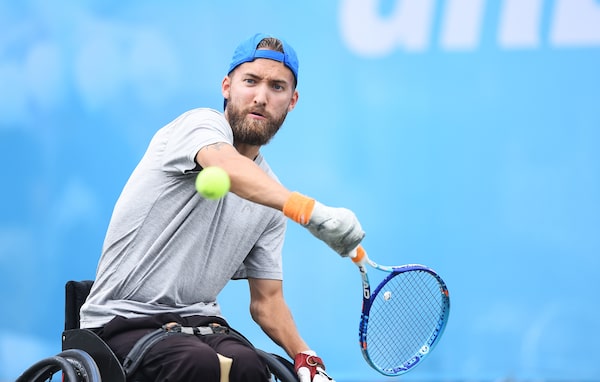
Robert Shaw competes against Bryan Barten of United States in the British Open Wheelchair Tennis Championships at Nottingham Tennis Centre in 2018 in Nottingham, England.Nathan Stirk/Getty Images
The first thing Rob Shaw did when he rolled onto a practice court outside Wimbledon was touch the grass to make sure it was real.
Shaw, a native of North Bay, Ont., is among the top-10 players in the world in the quad division of wheelchair tennis and he’s competed at dozens of international tournaments, including the Paralympic Games, the French Open, the U.S. Open and the Australian Open. But he’s never played at Wimbledon or on grass.
“The weirdest part was getting to a grass court and realizing that it’s real grass,” Shaw said Tuesday as he sat on a balcony overlooking Wimbledon’s maze of outdoor courts. “You know it’s going to be real grass, but for some reason in my head I didn’t think it’d be like a lawn at home or a fairway on the golf course. And it was. I felt it and, yeah, real ground, real grass.”
Quad tennis is for players who have impairments to at least three limbs. In Shaw’s case, a diving accident at the age of 21 left him with limited use of his legs, forearms, and hands.
But make no mistake, this is real tennis where serves can reach 170 kilometres per hour and players wheel around the court so fast that even though the rules allow for two bounces, there’s rarely more than one.
Shaw had been an avid tennis player long before the accident. He fell in love with the game as a child after being introduced to it by his father, a physician. He liked the stop-start rhythm of tennis over the mayhem of hockey and soccer.
He played competitively for a while and started coaching as well. He became such a fanatic that he and his buddy Bobby Ray formed a business when they were teenagers called ‘Raw Tennis.’ They travelled to towns around North Bay and offered tennis lessons and coaching clinics.
The Shaw children, all five of them, used to love fooling around by the family’s backyard pool. One day while doing a dive that he’d done countless times before, Shaw’s head glanced along the bottom of the pool. It was enough to dislodge two vertebrae. Even though they snapped back into place, and he didn’t require surgery, the dislocation left him partly paralyzed.
He gave up on all sports until Gary Luker stopped by the hospital one day. Luker played wheelchair tennis and he encouraged Shaw to give it a try. “I quickly eyed him up and down and thought, ‘If he can do it, I should be able to do it too,’ ” Shaw recalled.
Luker taught him how to push his chair on the court and how to tape his racquet to his hand for a better grip. “It was really hard to not constantly remember how easy the sport was standing up,” Shaw said. “And there was an ego adjustment where all these players didn’t know how good I was before. And now they’re just seeing how bad I am now.”
He slowly took to the sport and began winning events, including a gold medal at the 2019 Parapan American Games. He also got an undergraduate degree from McMaster University and moved to Kelowna, B.C., to pursue a doctorate in interdisciplinary studies at the University of British Columbia Okanagan. He now works for a non-profit organization called Spinal Cord Injury BC which provides support programs to people with spinal cord injuries.
Shaw, 33, is currently ranked seventh in the world, high enough for a place at Wimbledon which only has an eight-person quad tournament (the other Grand Slams invite 16 players). His first match is on Wednesday against world No. 2 Sam Schroder of the Netherlands and he’s also playing doubles.
The quad game has changed enormously in the past decade, Shaw said, with faster players, bigger tournaments and more prize money. The winner of the quad singles event at Wimbledon – there is only a men’s competition – will receive £60,000, or $102,000. Quad tennis is also being included in more ATP tournaments and the women’s game has picked up.
Shaw competes in about a dozen tournaments annually, mostly in Europe, and he needs to stay within the top 12 to qualify for next summer’s Paralympics. It’s a rigorous professional tour and some of the top players have corporate sponsorships. Wheelchair technology has also advanced to the point where competition chairs can cost around $15,000.
Shaw has also taken on the role of a mental-health ambassador for Tennis Canada along with Bianca Andreescu and Alexis Galarneau. The idea is to make sure players can access help when they need it.
Wheelchair athletes can be particularly vulnerable to mental-health issues. “Often times, playing comes with more challenges for us when chairs get broken or we have injuries that are disability specific and not just from tennis,” he said. “We want people to recognize that as wheelchair tennis players, we do the same grueling tour as the stand-up players.”
Now that he has gotten used to the grass and surroundings at Wimbledon, Shaw won’t be spending much of his free time watching big names such as Novak Djokovic. “Ever since being in a chair, I find the stand-up game far less intriguing to watch than the wheelchair game,” he said. “I think it’s because you recognize – and this is super-inappropriate wording – just how much easier and simpler the stand-up game is than the wheelchair game.”